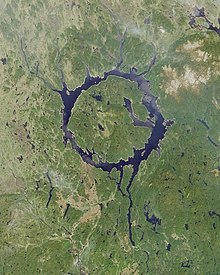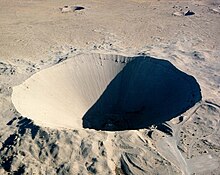Crater
A crater has classically been described as: "a bowl-shaped pit that is formed by a volcano, an explosion, or a meteorite impact".
[3] This requires that the crater have relatively even and solid walls, and a source of water such as floodwaters, rain, snow, springs, or other groundwater.
On other planets and moons that experience more active surface geological processes, such as Earth, Venus, Europa, Io and Titan, visible impact craters are less common because they become eroded, buried or transformed by tectonics over time.
Where such processes have destroyed most of the original crater topography, the terms impact structure or astrobleme are more commonly used.
A maar is a broad, low-relief volcanic crater caused by a phreatomagmatic eruption (an explosion which occurs when groundwater comes into contact with hot lava or magma).
A crater is formed by an explosive event through the displacement and ejection of material from the ground.
[15] Pit craters are found on Mercury, Venus,[16][17] Earth, Mars,[18] and the Moon.
In these cases, the craters may merge into a linear alignment and are commonly found along extensional structures such as fractures, fissures and graben.
[20][21] Pit craters are characterized by vertical walls that are often full of fissures and vents.
Subsidence craters are created as the roof of the cavity caused by the explosion collapses.





